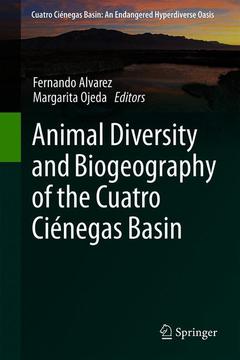Description
Animal Diversity and Biogeography of the Cuatro Ciénegas Basin, 1st ed. 2019
Cuatro Ciénegas Basin: An Endangered Hyperdiverse Oasis Series
Language: English
Subjects for Animal Diversity and Biogeography of the Cuatro...:
Publication date: 05-2019
231 p. · 15.5x23.5 cm · Hardback
231 p. · 15.5x23.5 cm · Hardback
Description
/li>Contents
/li>Biography
/li>Comment
/li>
This volume investigates the contemporary fauna that inhabit the Cuatro Ciénegas Basin. Divided into 15 chapters, it addresses and describes their diversity, taxonomic and biogeogaphic affinities, and ecological characteristics.
The Cuatro Ciénegas Valley is a unique oasis in the south-central region of the State of Coahuila, part of the Sonoran Desert, in Mexico. Several clues, specially derived from the study of the microbiota, suggest a very ancient origin of the valley and its permanence through time. This condition had promoted a high level of endemism and led to unique interactions between the resident species.
The fauna of the Cuatro Ciénegas Basin, a unique assemblage of species, habitats and evolutionary histories.- Helminth community structure of some freshwater fishes of the Cuatro Ciénegas Basin: patterns and processes.- Abundance and diversity of the soil microarthropod fauna from the Cuatro Ciénegas Basin.- Scorpion (Arachnida: Scorpiones) from the Cuatro Ciénegas Basin.- The spiders of the Churince region, Cuatro Ciénegas Basin: A comparison with other desert areas of North America.- Crustaceans from the Cuatro Ciénegas Basin: diversity, origin and endemism.- Spatial and temporal patterns of diversity of the Lepidopter (Papilionoidea sensu lato) in the Cuatro Ciénegas Basin.- Diversity and resource use patterns of bees and flies that visit flowers in the Cuatro Ciénegas Basin.- Odonata of the Cuatro Ciénegas Basin.- Diversity and community structure of ants in the Cuatro Ciénegas Basin, Coahuila, Mexico.- Prostigmatid mites (Arachnida: Acariformes: Prostigmata) parasitic on amphibians and reptiles in the Cuatro Ciénegas Basin.- Systematics of the fish from the Cuatro Ciénegas Basin.- Diversity of amphibians and reptiles in the Cuatro Ciénegas Basin.- The birds of the Cuatro Ciénegas Basin, a wetland within the Chihuahuan Desert.- Evaluating the hypothesis of Plesitocene refugia for mammals in the Cuatro Ciénegas Basin.- Index.
Fernando Alvarez obtained his B.Sc. degree in Biology from the School of Sciences at the National Autonomous University of Mexico (UNAM) in Mexico City. He subsequently completed his MSc degree at Tulane University in New Orleans, Louisiana and his PhD at the University of Maryland at College Park, Maryland, USA. In 1993 he was hired by the Institute of Biology, UNAM, where he is now a full Professor and became Curator of Crustacea. He has published 121 papers on the biology of Crustacea, mainly in systematics, ecology and evolution; he has written 29 book chapters and 8 books. He is currently Editor in Chief of Revista Mexicana de Biodiversidad, has been awarded level III in the National Researchers System of Mexico (SNI) and is a regular member of the Mexican Academy of Sciences.
Margarita Ojeda received her BSc degree in Biology from the School of Sciences at the National Autonomous University of Mexico (UNAM) in Mexico City in 1983, and then her MSc degree and PhD from the same university in 1990. She has published papers describing species of oribatid mites from Mexico, and on different topics such as the ecology and the role of the soil fauna. Since 2013, she has been an associated researcher at the National Acarology Collection of the Biology Institute at UNAM, and collaborates in different activities and projects concerning several groups of mites.
All chapters were written by a group of experts who have directly worked in the Cuatro Ciénegas Valley. Presents an updated account of the animal diversity found in the Cuatro Ciénegas Valley. The high levels of endemism, biogeographic affinities, and main ecological roles of the studied groups of animals are discussed. Close to 1,000 species are recorded, including new species, new records and exotic species. The conservation status of all the major groups of animals is analyzed.
© 2024 LAVOISIER S.A.S.




